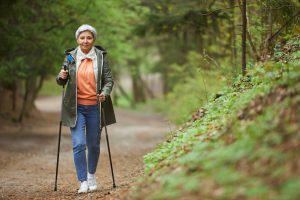
If you want to reduce your risk of type 2 diabetes, try walking! A new study published in Diabetes Care suggests that walking regularly at high intensity may help to prevent type 2 diabetes among 70- and 80-year-olds.
Advertisement
This study was one of the first to measure steps and pace among an older population. Researchers from multiple institutions came together to analyze data from the Women’s Health Initiative to characterize physical activity and cardiovascular health in post-menopausal women.
Participants in the study were 65 and older and did not have a diabetes diagnosis. All lived independently and were asked to wear a research-grade accelerometer for 24 hours a day over their right hip for one week. Their health was followed up for seven years.
The study’s primary aim was to understand the associations between total steps taken per day and the development of diabetes. Step intensity and cadence were also analyzed for any influence on diabetes risk.
The study concluded that those with a drop in physical activity were at a higher risk of type 2 diabetes. Researchers estimate that if older adults add 2,000 steps per day, many could reduce their risk of developing diabetes.
Previous studies have found that regular physical activity with an improved diet can reduce the risk of diabetes in older adults. The United States Department of Health and Human Services recommends at least 150 minutes of vigorous activity per week to reduce the risk of chronic diseases.
Keep Blood Sugar Levels in Check
Advertisement
Along with diet and exercise, it is important to keep blood sugar levels in check. Healthy Blood Sugar Support uses various ingredients to provide comprehensive support of healthy blood sugar and overall health.
Its unique formula of ingredients has been shown in human clinical studies to help support healthy cholesterol levels and blood pressure while also reducing excessive hunger or increased appetite, fatigue, and blood glucose spikes after meals.
With the rising numbers of diabetes in the older population, it is essential to take the steps necessary to help reduce the risk. Try to incorporate stepping into a daily routine, consume a healthy diet, and get the vitamins and minerals you need to keep blood sugar in a healthy range.
